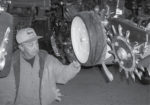What I've Learned from No-Tilling
Firsthand Experience Led No-Tiller To Advocate Practice In Nebraska
Conservation of soil, a better quality of life and the time to invent the TracPacker were all benefits of no-till for Dan Gillespie.
Read More















